| Adineta rhomboidea, creeping specimen; dorsoventral view. The arrows point to the characteristic rhomboidal elevation on the rump. (1) |
| |
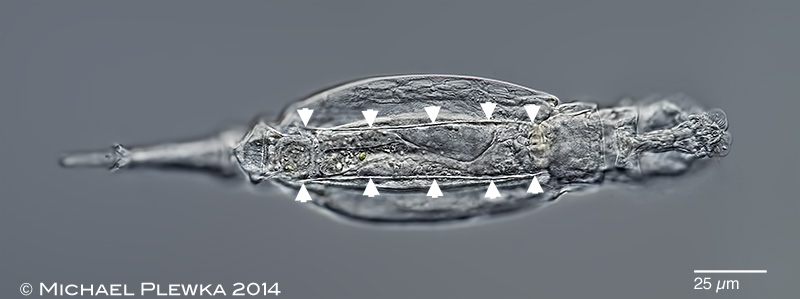 |
| Adineta rhomboidea, creeping specimen; dorsal view. This morphotype is characterised by some longitudinal folds of the dorsal integument (arrowheads). Also in focus are the two leaf-like rostral lamellae on the 1st pentagonal rostrum pseudosegment (see image below) (1) |
| |
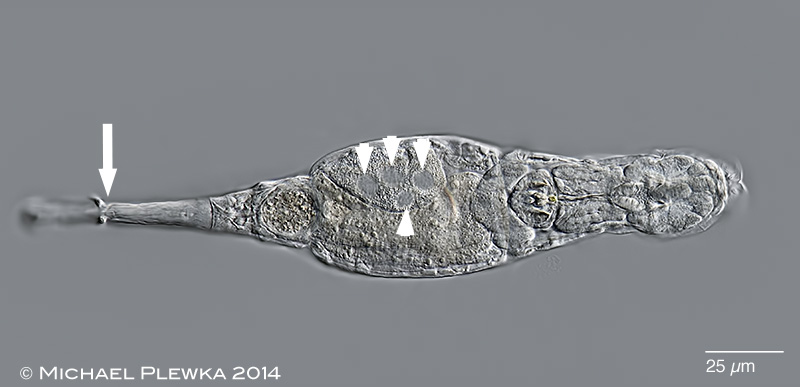 |
| Adineta rhomboidea, creeping specimen; dorsoventral view. The arrowheads point to 4 nuclei in the vitellarium. Although the narrow depth of field limits the chance to get all nuclei of the vitellarium in the same focal plane, later observations of similar morphotypes with video confirm that this species has only 4 nuclei in each vitellarium. The arrow points to the narrowing between the spore-bearing foot pseudosegment and the proximal foot pseudosegment. (2) |
| |
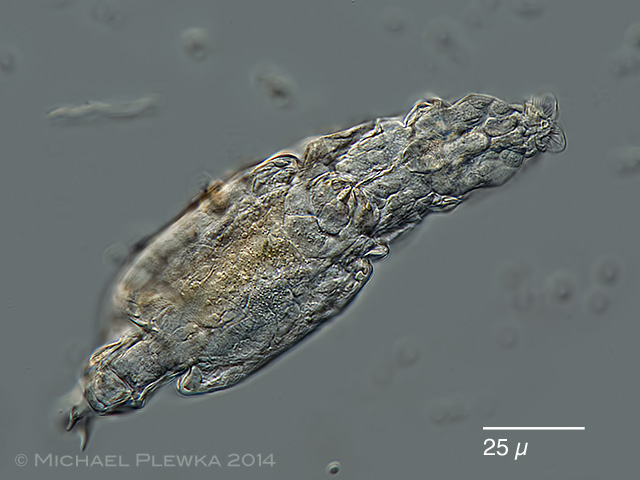 |
| Adineta rhomboidea,dorsoventral view. Focal plane on the rostrum lamella (see right image below). (1) |
|
|
Adineta rhomboidea, same specimen. Because the joint between the head pseudosegment (3rd segment) and the rostrum (1st & 2nd pseudosegment) is flexible (see lateral aspect below), the side protrusions of the rostrum lamella may have two different outlines depending on the position of the rostrum: leaf-like when the plane is parallel to the cover slide (upper left+ right/ lower left image) or "bird-wing-like" when perpendicular to the cover slide (lower right image).
Upper left image: dorsal view of the head region and the rostrum lamella, the lobes/ side protrusions of which appear leaf-like in this position. Two cavities on the rostrum (arrowheads).
Upper right image: head in optical median section. Hypodermis cells and buccal field are in focus. There is a pore at the base of the rostrum (arrow) (2).
Lower left image: two structures adjacent to the aforementioned cavities (arrowheads). (1)
Lower right image: optical transect of rostrum and rostrum lamella in frontal view. In this optical transect the two lobes/ side protrusions of rostrum lamella look like the silhouette of a flying seagull. Images not to scale. |
|
|
| Adineta rhomboidea, left: head with the prehensile apparatus constisting of two rakes with 5 U-hooks on each side. In former times A. rhomboidea was considered a variant of Adineta vaga (Berzins (1950). The number of U-hooks (NoUH) is one of the traits that is different form A. vaga (A. vaga: NoUH = 4 in each rake) and therefore justifies the species Adineta rhomboidea.(1) Right image: anterior part of compressed specimen, macerated with SDS, showing the rakes and trophi. The U-hooks/ denticles are artificially colored purple. The arrows point to those parts of the rakes that are actually light-refracting optical transects of the horn-like reinforcement structures (artificially colored green) in the living specimen (see also here). |
|
| |
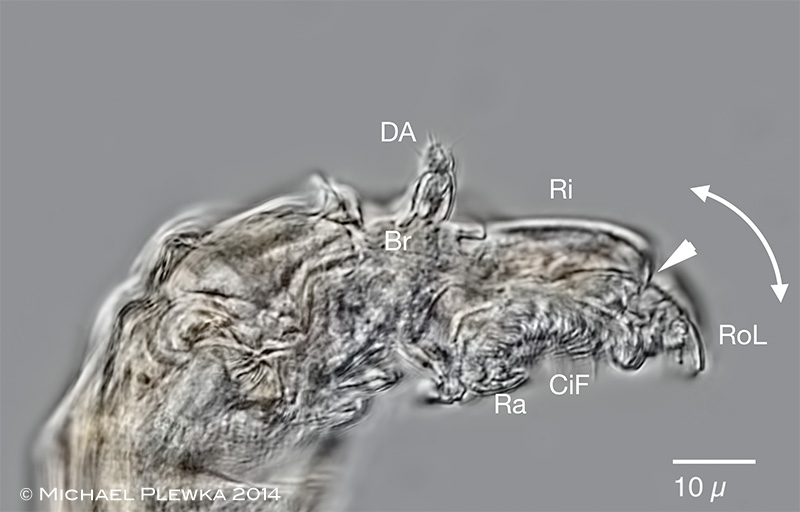 |
| Adineta rhomboidea; head, lateral view, optical median section; focus plane on the dorsal antenna DA).The arrowhead marks the flexible joint between the 3rd head pseudosegment (visible here is the ridge (Ri)) and the rostrum lamella (RoL) which can be moved up or down (bowed double arrow). Br: brain; Ci:ciliary field; R:- rake (1) |
| |
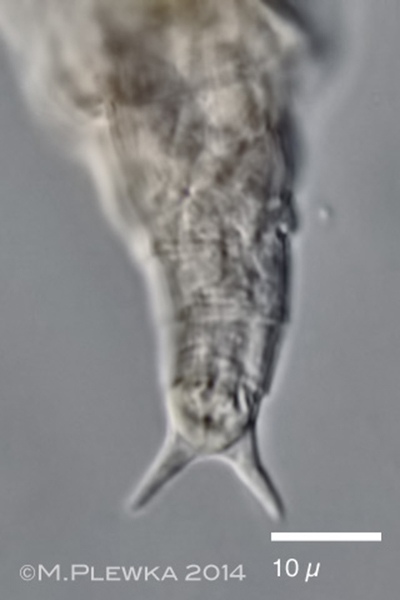 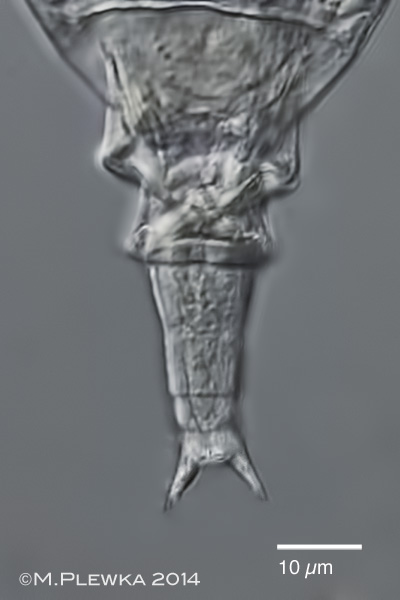 |
| Adineta rhomboidea; in contrast to another morphotype of A. rhomboidea (2) this morphotype has a foot with long tapering spurs. Interspace between spurs (1) |
| |
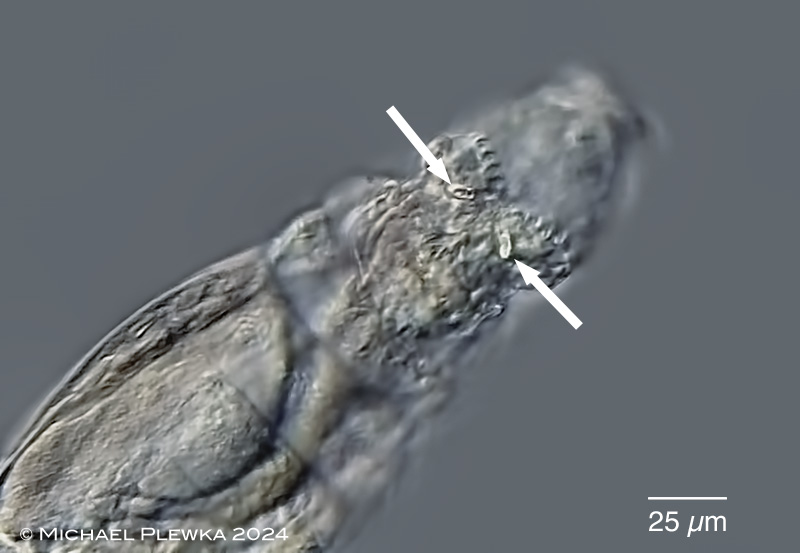 |
| Adineta rhomboidea; Donner (1965) mentions a trait that had been observed by Berzins: two (triangular) light refracting bodies near the dorsal antenna (i.e. neck segment). Unfortunately I do not have access to the original literature of Berzins, so I do not know what kind of microscope was used. In the DIC-microscope, however, there are two light refracting structures quite common in genus Adineta (marked by arrows). These structures are part of the rakes; the function may be the reinforcement of the rake plates (See image of rakes above). In 2-dimensional transmitted light observation these two "light refracting bodies" are then near the dorsal antenna. (1) |
| |
| |
| |
| Location: Speikboden (altitude 2400m), Tauferer Ahrntal, South Tirol, Italy (1); (2) |
| Habitat: dry moss on rocks (Andreaea rupestris), together with A. tuberculosa, Pleuretra lineata; Dissotrocha scutellata (1); |
| Date: coll. 7.10.2014, img 18.10.2014.(1); 18.10.2014.(1); 26.10.2014 |
| |
| Identification by courtesy of Nataliia Iakovenko, University of Ostrava, Czech republic |
|